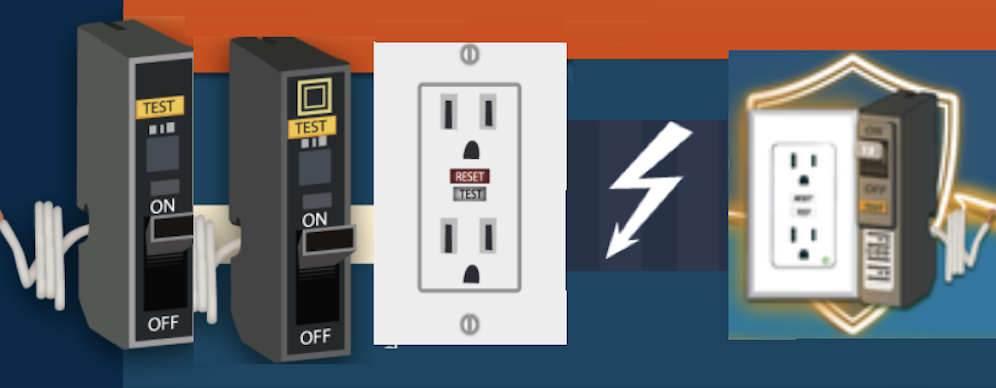AFCI vs. GFCI: All You Need To Know About Circuit Interrupters
Your home’s electrical system needs regular testing and evaluation in order to assess its level of wear and tear, as well as to prevent dangerous situations. There are several upgrades that one can install in order to ensure the proper function of their electrical system, two of which are of utmost importance: ground fault circuit interrupters (GFCIs) and arc fault circuit interrupters (AFCIs).
The Electrical Safety Foundation International has published a report showing the great reduction in total electrocutions and consumer products electrocutions as a result of ground fault circuit interrupters. It also provides great guidelines on renovating a home to code and the importance of both GFCIs and AFCIs when it comes to safe electrical installation.
AFCI vs. GFCI: What’s The Difference?
So what is the difference between an AFCI outlet and a GFCI outlet? Or between the AFCI breaker and a GFCI breaker? They all protect from electrical hazards and are defined as electrical safety devices. Check out our table below to understand the different potentially dangerous situations that these devices protect against and how they function.
Safety Device | AFCI | GFCI |
| Type of hazard | An arc fault is a hazardous condition that happens when there’s damage to electrical wiring, loose electrical terminations or connections. These create dangerous arcing or high temperatures that can easily ignite nearby materials. | A ground fault is a hazardous condition that happens when current takes an intentional path back to the electricity source by touching a grounded surface. E.g: the metal surface of the toaster becomes energized and a person touches it, thus unintentionally becoming the path for fault current. |
| Available Devices | Circuit breaker | Circuit breaker |
| Functionality | An arc-fault circuit interrupter monitors the current within a circuit and detects potentially dangerous arcing signatures, cutting off power. These devices protect against electrical sparks and fires. | A ground-fault circuit interrupter de-energizes the electricity when current to ground surpasses a certain value, therefore protecting people from electrical shock. Note: most GFCIs are designed to stop electricity flow when leakage current is between 4 and 6 mAmps. |
AFCI vs. GFCI: Where Are They Required?
The National Electrical Code has very specific requirements when it comes to different areas of your home and what type of protection they call for. When ground-fault circuit interrupters were first introduced 50 years ago, they were only required for swimming pools. Today, the list is far more extensive and GFCI protection is expected in approximately 50 locations according to the NEC. When it comes to houses, and multifamily building, the more common areas requiring GFCI protection are:
- Bathrooms
- Bathtubs and shower stalls – this is required when there are receptacles within 6 feet of the tub or shower
- Sinks – as above, this is required when there are receptacles within 6 feet of the inside edge of the sink
- Kitchens – this is required where there are receptacles in the countertop area
- Kitchen dishwashers
- Laundry rooms
- Garages or any accessory buildings with floors at or below grade level (used for either storage or work areas)
- Crawl spaces
- Outdoors (including balconies, decks and porches)
- Basements
- Boathouses
Having GFCI protection is very important, and their effectiveness has been proven time and time again. The Consumer Product Safety Commission has estimated that approximately 50% of home electrocutions have been prevented due to the introduction of GFCIs.
GFCI protection can often be installed at the first receptacle on a branch circuit, but that’s not the case with AFCI protection. This is intended at the electrical panel, and just like the GFCIs, they need to be readily accessible so that they can be reached and inspected quickly. The NEC requires AFCI protection in:
- Kitchens
- Living rooms
- Dining rooms
- Parlors and family rooms
- Bedrooms and dens
- Libraries and recreation rooms
- Laundry rooms
- Hallways and closets
- Sunrooms
Similar to GFCIs, the CPSC estimated that more than 50% of electrical fires occurring every year could be prevented by the installation of AFCIs. These devices are available as branch or feeder AFCI breaker, combination type AFCI breaker and AFCI receptacle.
Testing AFCIs and GFCIs
Both arc-fault current interrupters and ground-fault circuit interrupters should be tested monthly. These devices come with test switches and they’re quite easy to test.
4 Steps to Test a GFCI
- Push the RESET button
- Plug in a lighting device, such as a nightlight or a lamp – the device should be ON
- Press the TEST button on the GFCI – at this point the lamp or nightlight should turn OFF
- Push RESET again – now the device should turn back ON
If any step during the test doesn’t work as it should, then the receptacle is most likely faulty and you should call a professional electrician to inspect it. Moreover, consider checking your receptacles and switches regularly, it’s always wise to address warning signs early on.
4 Steps to Test a AFCI
- Leave some lights or other devices on, such as a TV, your laptop, etc.
- Locate your electrical panel and, with your breaker in the on position, push the AFCI “TEST” button – the breaker should trip and move the switch to OFF position (if there is a middle “TRIP” position, it will switch there)
- Flip the breaker all the way to position OFF before turning it back ON
- Repeat for all AFCI breakers.
If they trip when you push the “TEST” button, then your AFCIs are working, but if any of the breakers doesn’t trip, then it needs replacing.
AFCI receptacles protect appliances from both series and parallel arcs. They also protect both downstream and upstream wire, between the source of the circuit and the first outlet on the circuit, which is usually called the “home run.” AFCI receptacles are also equipped with localized TEST and RESET abilities.
A Simple Electrical Upgrade Can Upgrade Your Quality of Life
The right electrical upgrade can dramatically improve the value and appearance of any home or business. You’ll be amazed at what a difference the right electrical upgrade can make for your home or business. Make sure that when you select an electrical company to do the enhancement of your home and you have decided to take your enhancement to the level where you require an electrical upgrade that the technician at the company has a good working knowledge and the experience to properly guide you in this area.
When you decide to upgrade, our well-trained and certified electricians have all the experience and training needed to complete your electrical panel upgrade project from start to finish, with a minimum of fuss or disturbance. Please contact us right away at 310-800-2401



